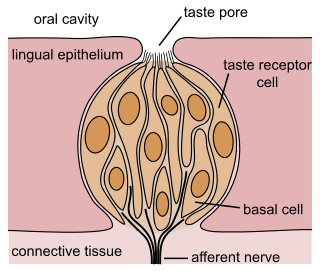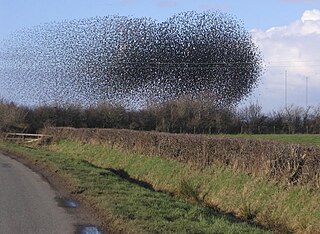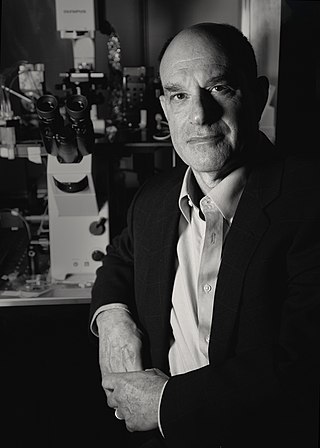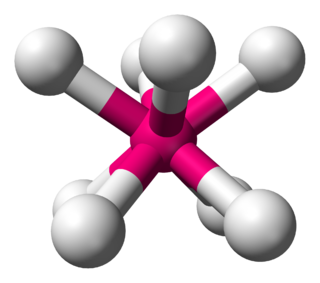Related Research Articles
Nociception is the sensory nervous system's process of encoding noxious stimuli. It deals with a series of events and processes required for an organism to receive a painful stimulus, convert it to a molecular signal, and recognize and characterize the signal in order to trigger an appropriate defense response.
Pleasure refers to experience that feels good, that involves the enjoyment of something. It contrasts with pain or suffering, which are forms of feeling bad. It is closely related to value, desire and action: humans and other conscious animals find pleasure enjoyable, positive or worthy of seeking. A great variety of activities may be experienced as pleasurable, like eating, having sex, listening to music or playing games. Pleasure is part of various other mental states such as ecstasy, euphoria and flow. Happiness and well-being are closely related to pleasure but not identical with it. There is no general agreement as to whether pleasure should be understood as a sensation, a quality of experiences, an attitude to experiences or otherwise. Pleasure plays a central role in the family of philosophical theories known as hedonism.
Dysgeusia, also known as parageusia, is a distortion of the sense of taste. Dysgeusia is also often associated with ageusia, which is the complete lack of taste, and hypogeusia, which is a decrease in taste sensitivity. An alteration in taste or smell may be a secondary process in various disease states, or it may be the primary symptom. The distortion in the sense of taste is the only symptom, and diagnosis is usually complicated since the sense of taste is tied together with other sensory systems. Common causes of dysgeusia include chemotherapy, asthma treatment with albuterol, and zinc deficiency. Liver disease, hypothyroidism, and rarely certain types of seizures can also lead to dysgeusia. Different drugs could also be responsible for altering taste and resulting in dysgeusia. Due to the variety of causes of dysgeusia, there are many possible treatments that are effective in alleviating or terminating the symptoms of dysgeusia. These include artificial saliva, pilocarpine, zinc supplementation, alterations in drug therapy, and alpha lipoic acid.

The sensory nervous system is a part of the nervous system responsible for processing sensory information. A sensory system consists of sensory neurons, neural pathways, and parts of the brain involved in sensory perception. Commonly recognized sensory systems are those for vision, hearing, touch, taste, smell, and balance. Senses are transducers from the physical world to the realm of the mind where people interpret the information, creating their perception of the world around them.

In physiology, a stimulus is a detectable change in the physical or chemical structure of an organism's internal or external environment. The ability of an organism or organ to detect external stimuli, so that an appropriate reaction can be made, is called sensitivity (excitability). Sensory receptors can receive information from outside the body, as in touch receptors found in the skin or light receptors in the eye, as well as from inside the body, as in chemoreceptors and mechanoreceptors. When a stimulus is detected by a sensory receptor, it can elicit a reflex via stimulus transduction. An internal stimulus is often the first component of a homeostatic control system. External stimuli are capable of producing systemic responses throughout the body, as in the fight-or-flight response. In order for a stimulus to be detected with high probability, its level of strength must exceed the absolute threshold; if a signal does reach threshold, the information is transmitted to the central nervous system (CNS), where it is integrated and a decision on how to react is made. Although stimuli commonly cause the body to respond, it is the CNS that finally determines whether a signal causes a reaction or not.
Stimulus modality, also called sensory modality, is one aspect of a stimulus or what is perceived after a stimulus. For example, the temperature modality is registered after heat or cold stimulate a receptor. Some sensory modalities include: light, sound, temperature, taste, pressure, and smell. The type and location of the sensory receptor activated by the stimulus plays the primary role in coding the sensation. All sensory modalities work together to heighten stimuli sensation when necessary.
In psychophysics, sensory threshold is the weakest stimulus that an organism can sense. Unless otherwise indicated, it is usually defined as the weakest stimulus that can be detected half the time, for example, as indicated by a point on a probability curve. Methods have been developed to measure thresholds in any of the senses.
Thermal comfort is the condition of mind that expresses satisfaction with the thermal environment and is assessed by subjective evaluation. The human body can be viewed as a heat engine where food is the input energy. The human body will release excess heat into the environment, so the body can continue to operate. The heat transfer is proportional to temperature difference. In cold environments, the body loses more heat to the environment and in hot environments the body does not release enough heat. Both the hot and cold scenarios lead to discomfort. Maintaining this standard of thermal comfort for occupants of buildings or other enclosures is one of the important goals of HVAC design engineers.

Frisson, also known as aesthetic chills or psychogenic shivers, is a psychophysiological response to rewarding stimuli that often induces a pleasurable or otherwise positively-valenced affective state and transient paresthesia, sometimes along with piloerection and mydriasis . The sensation commonly occurs as a mildly to moderately pleasurable emotional response to music with skin tingling; piloerection and pupil dilation not necessarily occurring in all cases.

The gustatory nucleus is the rostral part of the solitary nucleus located in the medulla. The gustatory nucleus is associated with the sense of taste and has two sections, the rostral and lateral regions. A close association between the gustatory nucleus and visceral information exists for this function in the gustatory system, assisting in homeostasis - via the identification of food that might be possibly poisonous or harmful for the body. There are many gustatory nuclei in the brain stem. Each of these nuclei corresponds to three cranial nerves, the facial nerve (VII), the glossopharyngeal nerve (IX), and the vagus nerve (X) and GABA is the primary inhibitory neurotransmitter involved in its functionality. All visceral afferents in the vagus and glossopharyngeal nerves first arrive in the nucleus of the solitary tract and information from the gustatory system can then be relayed to the thalamus and cortex.
The primary gustatory cortex is a brain structure responsible for the perception of taste. It consists of two substructures: the anterior insula on the insular lobe and the frontal operculum on the inferior frontal gyrus of the frontal lobe. Because of its composition the primary gustatory cortex is sometimes referred to in literature as the AI/FO(Anterior Insula/Frontal Operculum). By using extracellular unit recording techniques, scientists have elucidated that neurons in the AI/FO respond to sweetness, saltiness, bitterness, and sourness, and they code the intensity of the taste stimulus.

The gustatory system or sense of taste is the sensory system that is partially responsible for the perception of taste (flavor). Taste is the perception produced or stimulated when a substance in the mouth reacts chemically with taste receptor cells located on taste buds in the oral cavity, mostly on the tongue. Taste, along with olfaction and trigeminal nerve stimulation, determines flavors of food and other substances. Humans have taste receptors on taste buds and other areas, including the upper surface of the tongue and the epiglottis. The gustatory cortex is responsible for the perception of taste.
Extinction is a neurological disorder that impairs the ability to perceive multiple stimuli of the same type simultaneously. Extinction is usually caused by damage resulting in lesions on one side of the brain. Those who are affected by extinction have a lack of awareness in the contralesional side of space and a loss of exploratory search and other actions normally directed toward that side.
A sense is a biological system used by an organism for sensation, the process of gathering information about the world through the detection of stimuli. Although traditionally five human senses were identified as such, it is now recognized that there are many more. Senses used by non-human organisms are even greater in variety and number. During sensation, sense organs collect various stimuli for transduction, meaning transformation into a form that can be understood by the brain. Sensation and perception are fundamental to nearly every aspect of an organism's cognition, behavior and thought.

Active matter is matter composed of large numbers of active "agents", each of which consumes energy in order to move or to exert mechanical forces. Such systems are intrinsically out of thermal equilibrium. Unlike thermal systems relaxing towards equilibrium and systems with boundary conditions imposing steady currents, active matter systems break time reversal symmetry because energy is being continually dissipated by the individual constituents. Most examples of active matter are biological in origin and span all the scales of the living, from bacteria and self-organising bio-polymers such as microtubules and actin, to schools of fish and flocks of birds. However, a great deal of current experimental work is devoted to synthetic systems such as artificial self-propelled particles. Active matter is a relatively new material classification in soft matter: the most extensively studied model, the Vicsek model, dates from 1995.

David Jay Julius is an American physiologist and Nobel Prize laureate known for his work on molecular mechanisms of pain sensation and heat, including the characterization of the TRPV1 and TRPM8 receptors that detect capsaicin, menthol, and temperature. He is a professor at the University of California, San Francisco.

In chemistry, the square antiprismatic molecular geometry describes the shape of compounds where eight atoms, groups of atoms, or ligands are arranged around a central atom, defining the vertices of a square antiprism. This shape has D4d symmetry and is one of the three common shapes for octacoordinate transition metal complexes, along with the dodecahedron and the bicapped trigonal prism.
Erio Tosatti is an Italian theoretical physicist active at the International School for Advanced Studies (SISSA), and at the Abdus Salam International Centre for Theoretical Physics (ICTP), both in Trieste, Italy. He is a broad-scope theorist who carried out research on a wide range of condensed matter physics phenomena. His early work dealt with optical properties, electron energy loss, theory of excitons and nonlocal dielectric response in solids, including layer crystals such as graphite and semiconductors; charge- and spin-density-waves; surface physics in all its aspects, particularly reconstruction, roughening and melting, also in clusters; the prediction the Berry phase in fullerene; the first calculated STM map of graphite, now a standard in the field; matter at extreme pressures: carbon, oxygen, hydrogen, CO2, iron at earth core conditions, water and ammonia at deep planetary conditions, pressure-induced insulator-metal transitions in layer compounds like MoS2. In nanophysics, he and his group predicted helical structures of metal nanowires; the spontaneous magnetism of metal nanocontacts, including the electronic circumstances for normal or ferromagnetic Kondo effect therein. His and his collaborator's theory of strongly correlated superconductivity was recently confirmed in compounds such as Cs3C60. Pioneering papers on quantum annealing are now basic to current developments in quantum computing. More recently he moved on to the theory of nanofriction, a field where he obtained the ERC Advanced Grant MODPHYSFRICT 2013–2019, and subsequently, as co-PI with an experimental group, another ERC Advanced Grant ULTRADISS 2019-2024. More details of his current and past research activity can be found here.
Michel Lazdunski is a French biologist specializing in biochemistry, physiology, pathophysiology, molecular pharmacology and neuroscience.

William Archer Hagins was an American medical researcher. He was chief of the Section of Membrane Biophysics in National Institute of Diabetes and Digestive and Kidney Diseases's Laboratory of Chemical Physics upon his retirement in 2007. Hagins and colleagues made the seminal discovery of the dark current in photoreceptor cells. This finding became central to understanding how the visual cells worked and led to knowledge of the importance of reattaching a detached retina as soon as possible for continued use. As a fellow of Fulbright Program, he'd also served in the United States Navy as a Research Medical Officer. He joined NIDDK's Laboratory of Physical Biology in 1958, doing independent research in the Section of Photobiology, headed by Frederick Sumner Brackett. Hagins was a mentor to many, particularly through his work with the Brackett Foundation.
References
- ↑ Cabanac, Michel (1971-09-17). "Physiological Role of Pleasure". Science. 173 (4002): 1103–1107. Bibcode:1971Sci...173.1103C. doi:10.1126/science.173.4002.1103. ISSN 0036-8075. PMID 5098954. S2CID 38234571.
- ↑ Parkinson, Thomas; de Dear, Richard (2014-12-15). "Thermal pleasure in built environments: physiology of alliesthesia". Building Research & Information. 43 (3): 288–301. doi:10.1080/09613218.2015.989662. ISSN 0961-3218. S2CID 109419103.
- ↑ Cabanac, M; Minaire, Y; Adair, ER (1968). "Influence of internal factors on the pleasantness of a gustative sweet sensation". Commun Behav Biol A. 1: 77–82.
- ↑ Cabanac, M; Duclaux, R (1970). "Specificity of internal signals in producing satiety for taste stimuli". Nature. 227 (5261): 966–7. Bibcode:1970Natur.227..966C. doi:10.1038/227966a0. PMID 4915408. S2CID 4193888.
- ↑ Cabanac, Michel (1971-09-17). "Physiological Role of Pleasure". Science. 173 (4002): 1103–1107. Bibcode:1971Sci...173.1103C. doi:10.1126/science.173.4002.1103. ISSN 0036-8075. PMID 5098954. S2CID 38234571.
- ↑ Cabanac, M; Lafrance, L (1990). "Postingestive alliesthesia: the rat tells the same story". Physiology & Behavior. 47 (3): 539–43. doi:10.1016/0031-9384(90)90123-L. PMID 2359766. S2CID 37735253.